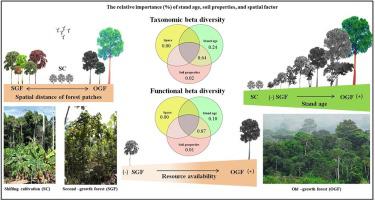Forest Ecology and Management ( IF 3.7 ) Pub Date : 2020-12-25 , DOI: 10.1016/j.foreco.2020.118885 Pedro Manuel Villa , Sebastião Venâncio Martins , Écio Souza Diniz , Silvio Nolasco de Oliveira Neto , Andreza Viana Neri , Herval Pinto-Junior , Jaquelina Alves Nunes , Marcelo Leandro Bueno , Arshad Ali

|
Predicting how multiple drivers shape beta diversity across tropical forest is one of the most important issues in ecology. However, the relative importance of drivers to the spatial and temporal dissimilarities in woody species composition (beta diversity) along Amazon forest succession remains poorly studied. In this study, we assessed how stand age (factor related to habitat filtering and succession), soil properties (factors related to resource availability and environmental filtering) and forest patches distance (spatial factor related to dispersal limitation) affect the taxonomic and functional beta diversity along an Amazon forest succession. Taxonomic and functional beta diversity indices were quantified based on abundance-based metrics and trait-based approach using functional traits related to plant dispersion and growth. Overall, taxonomic and functional beta diversity was consistently higher in initial successional stage among plots and sites; however, old-growth forest presented the lowest functional beta diversity. We observed differences in beta diversity components among successional stages and old-growth forest. The beta diversity components showed a clear higher pattern in the different second-growth forests than in the old-growth forest. Soil fertility and stand age explained most of the variation in taxonomic and functional turnover and beta diversity. This pattern probably is an outcome of the patches within a continuous old-growth forest as main seed sources for the colonization and establishment of tree species. We observed that functional beta diversity was lower than taxonomic beta diversity; therefore we presumed that there is higher functional redundancy in old-growth forests, compared to taxonomic beta diversity. However, despite the lower functional beta diversity and higher functional redundancy in old-growth forest, probably shade-tolerant species have different functions than second-growth forests that re-growing after shifting cultivation. We argue that an old-growth forest has lower functional diversity than second-growth forests but, it is probably induced by a high turnover of second-growth forests.
中文翻译:

亚马逊河森林演替区木本群落的分类学和功能性β多样性:林分年龄,土壤特性和空间因素的相对重要性
预测多种驱动因素如何影响热带森林的β多样性是生态学中最重要的问题之一。然而,驱动器对亚马逊森林演替过程中木质物种组成(β多样性)的时空差异的相对重要性仍然缺乏研究。在这项研究中,我们评估了林分年龄(与生境过滤和演替有关的因素),土壤特性(与资源可获得性和环境过滤有关的因素)和森林斑块距离(与扩散限制有关的空间因素)如何影响分类学和功能β多样性沿亚马逊森林演替。使用与植物分散和生长相关的功能性状,基于基于丰度的指标和基于性状的方法对生物分类学和功能性β多样性指数进行了量化。总体,在地块和地点的初始演替阶段,分类学和功能性β多样性一直较高;然而,老龄森林的功能性β多样性最低。我们观察到演替阶段和旧林之间的β多样性成分存在差异。在不同的次生林中,相比于旧生林,β多样性成分表现出明显更高的模式。土壤肥力和林分年龄解释了生物分类和功能更新以及β多样性的大部分变化。这种模式可能是连续的旧林中斑块的结果,这些林是树木定植和建立的主要种子来源。我们观察到,功能性β多样性低于分类学性β多样性。因此,我们认为与分类学Beta多样性相比,旧林中的功能冗余更高。但是,尽管老龄林中的功能性β多样性较低,而功能性冗余性较高,但耐荫树种的功能可能与第二代森林不同,后者在轮番种植后重新生长。我们认为,老龄林的功能多样性要比次生林低,但它可能是由次生林的高周转率引起的。


























 京公网安备 11010802027423号
京公网安备 11010802027423号